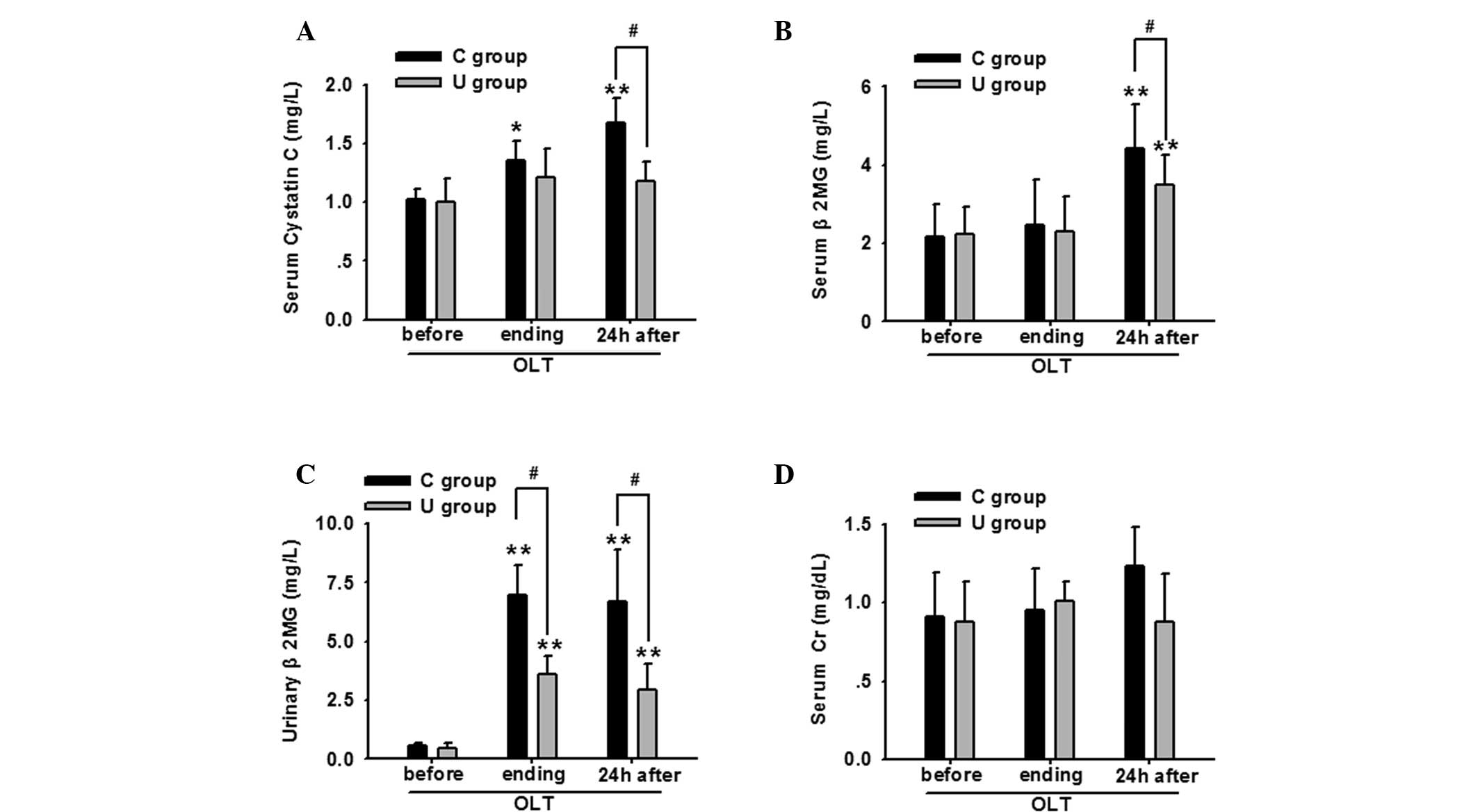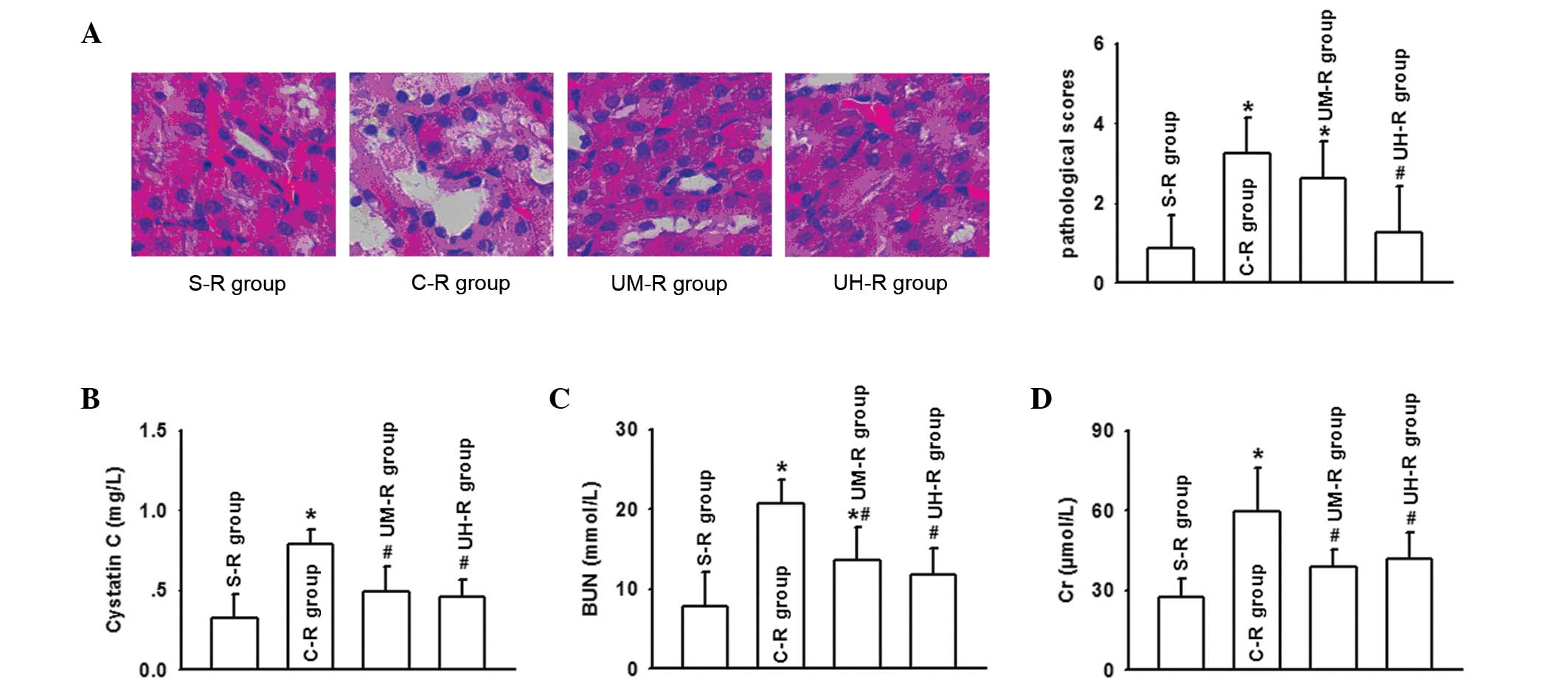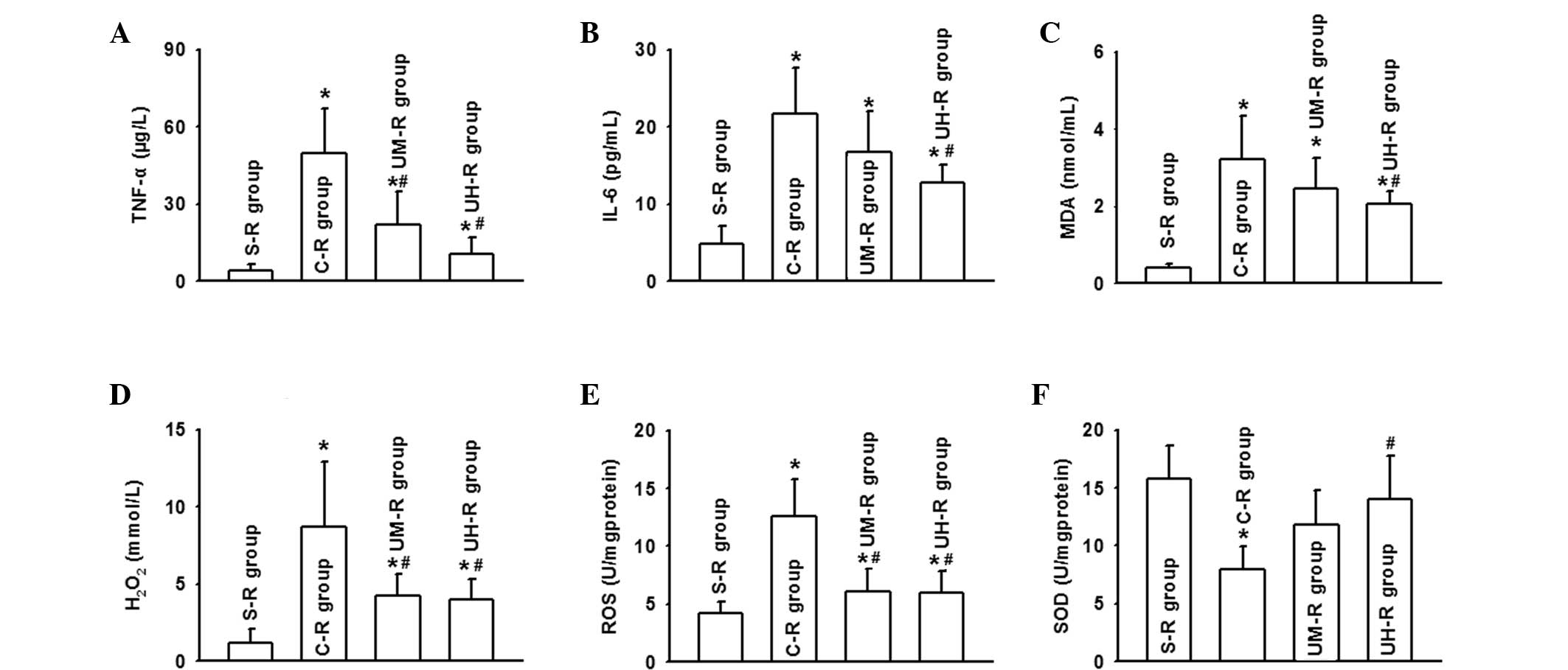|
1
|
Barri YM, Sanchez EQ, Jennings LW, et al:
Acute kidney injury following liver transplantation: definition and
outcome. Liver Transpl. 15:475–483. 2009. View Article : Google Scholar : PubMed/NCBI
|
|
2
|
Sirota JC, Walcher A, Faubel S, et al:
Urine IL-18, NGAL, IL-8 and serum IL-8 are biomarkers of acute
kidney injury following liver transplantation. BMC Nephrol.
14:172013. View Article : Google Scholar : PubMed/NCBI
|
|
3
|
Lima EQ, Zanetta DM, Castro I, et al: Risk
factors for development of acute renal failure after liver
transplantation. Ren Fail. 25:553–560. 2003. View Article : Google Scholar : PubMed/NCBI
|
|
4
|
Umeadi C, Kandeel F and Al-Abdullah IH:
Ulinastatin is a novel protease inhibitor and neutral protease
activator. Transplant Proc. 40:387–389. 2008. View Article : Google Scholar : PubMed/NCBI
|
|
5
|
Yu JB and Yao SL: Protective effects of
hemin pretreatment combined with ulinastatin on septic shock in
rats. Chin Med J (Engl). 121:49–55. 2008.
|
|
6
|
Liu R, Qi H, Wang J, et al: Ulinastatin
activates the renin-angiotensin system to ameliorate the
pathophysiology of severe acute pancreatitis. J Gastroenterol
Hepatol. 29:1328–1337. 2014. View Article : Google Scholar : PubMed/NCBI
|
|
7
|
Xiao J, Zhu X, Ji G, et al: Ulinastatin
protects cardiomyocytes against ischemia-reperfusion injury by
regulating autophagy through mTOR activation. Mol Med Rep.
10:1949–1953. 2014.PubMed/NCBI
|
|
8
|
Yang Q, Liu X, Liu M, Zhang L and Guan Y:
Ulinastatin-mediated protection against zymosan-induced multiple
organ dysfunction in rats. Biologicals. 38:552–556. 2010.
View Article : Google Scholar : PubMed/NCBI
|
|
9
|
Romano TG, Schmidtbauer I, Silva FM,
Pompilio CE, D’Albuquerque LA and Macedo E: Role of MELD score and
serum creatinine as prognostic tools for the development of acute
kidney injury after liver transplantation. PloS One. 8:e640892013.
View Article : Google Scholar : PubMed/NCBI
|
|
10
|
Zhou Y, Xia L, He ZS, Ouyang W, Z H and
Xie CH: Modulation of matrix metalloproteinase-9 and tissue
inhibitor of metalloproteinase-1 in RAW264.7 cells by irradiation.
Mol Med Rep. 3:809–813. 2010.
|
|
11
|
Mehta RL, Kellum JA, Shah SV, et al; Acute
Kidney Injury Network. Acute Kidney Injury Network: report of an
initiative to improve outcomes in acute kidney injury. Crit Care.
11:R312007. View
Article : Google Scholar : PubMed/NCBI
|
|
12
|
Chi X, Zhang A, Luo G, et al: Knockdown of
myeloid differentiation protein-2 reduces acute lung injury
following orthotopic autologous liver transplantation in a rat
model. Pulm Pharmacol Ther. 26:380–387. 2013. View Article : Google Scholar : PubMed/NCBI
|
|
13
|
Ge M, Chi X, Zhang A, et al: Intestinal
NF-E2-related factor-2 expression and antioxidant activity changes
in rats undergoing orthotopic liver autotransplantation. Oncol
Lett. 6:1307–1312. 2013.PubMed/NCBI
|
|
14
|
Kong HY, Chen F, He Y, et al: Intrarenal
resistance index for the assessment of acute renal injury in a rat
liver transplantation model. BMC Nephrol. 14:552013. View Article : Google Scholar : PubMed/NCBI
|
|
15
|
Ostermann M and Chang R; Riyadh ICU
Program Users Group. Correlation between the AKI classification and
outcome. Crit Care. 12:R1442008. View
Article : Google Scholar : PubMed/NCBI
|
|
16
|
Ricci Z, Cruz DN and Ronco C:
Classification and staging of acute kidney injury: beyond the RIFLE
and AKIN criteria. Nat Rev Nephrol. 7:201–208. 2011. View Article : Google Scholar : PubMed/NCBI
|
|
17
|
Klaus F, Keitel da Silva C, Meinerz G, et
al: Acute kidney injury after liver transplantation: incidence and
mortality. Transplant Proc. 46:1819–1821. 2014. View Article : Google Scholar : PubMed/NCBI
|
|
18
|
Narciso RC, Ferraz LR, Mies S, et al:
Impact of acute kidney injury exposure period among liver
transplantation patients. BMC Nephrol. 14:432013. View Article : Google Scholar : PubMed/NCBI
|
|
19
|
Walsh TS, Hopton P, Garden OJ and Lee A:
Effect of graft reperfusion on haemodynamics and gas exchange
during liver transplantation. Br J Anaesth. 81:311–316. 1998.
View Article : Google Scholar : PubMed/NCBI
|
|
20
|
Liu Y, Yang L, Tao K, et al: Protective
effects of hydrogen enriched saline on liver ischemia reperfusion
injury by reducing oxidative stress and HMGB1 release. BMC
Gastroenterol. 14:122014. View Article : Google Scholar : PubMed/NCBI
|
|
21
|
Iasi M, Favero SG, Soler WV, et al:
Oxidative stress in liver transplantation with special reference to
Santa Casa-SP solution: a preclinical study. Transplant Proc.
35:1134–1135. 2003. View Article : Google Scholar : PubMed/NCBI
|
|
22
|
Song Z, Chen G, Lin G, Jia C, Cao J and Ao
G: The ultra-early protective effect of ulinastatin on rabbit acute
lung injury induced by paraquat. BMC Emerg Med. 13(Suppl 1):
S72013.PubMed/NCBI
|
|
23
|
Yang H, Mao Y, Lu X, et al: The effects of
urinary trypsin inhibitor on liver function and inflammatory
factors in patients undergoing hepatectomy: a prospective,
randomized, controlled clinical study. Am J Surg. 202:151–157.
2011. View Article : Google Scholar : PubMed/NCBI
|
|
24
|
Gao C, Huan J, Li W and Tang J: Protective
effects of ulinastatin on pancreatic and renal damage in rats
following early scald injury. Burns. 35:547–552. 2009. View Article : Google Scholar : PubMed/NCBI
|
|
25
|
Chen CC, Liu ZM, Wang HH, He W, Wang Y and
Wu WD: Effects of ulinastatin on renal ischemia-reperfusion injury
in rats. Acta Pharmacol Sin. 25:1334–1340. 2004.PubMed/NCBI
|
|
26
|
Hori T, Uemoto S, Chen F, et al: Oxidative
stress and extracellular matrices after hepatectomy and liver
transplantation in rats. World J Hepatol. 6:72–84. 2014.PubMed/NCBI
|
|
27
|
Hori T, Uemoto S, Walden LB, et al:
Pretreatment of small-for-size grafts in vivo by γ-aminobutyric
acid receptor regulation against oxidative stress-induced injury in
rat split orthotopic liver transplantation. Int J Hepatol.
2013:1491232013.
|
|
28
|
Kadkhodaee M, Mikaeili S, Zahmatkesh M, et
al: Alteration of renal functional, oxidative stress and
inflammatory indices following hepatic ischemia-reperfusion. Gen
Physiol Biophys. 31:195–202. 2012. View Article : Google Scholar : PubMed/NCBI
|
|
29
|
Palsamy P and Subramanian S: Resveratrol
protects diabetic kidney by attenuating hyperglycemia-mediated
oxidative stress and renal inflammatory cytokines via Nrf2-Keap1
signaling. Biochim Biophys Acta. 1812:719–731. 2011. View Article : Google Scholar : PubMed/NCBI
|
|
30
|
Kyriakidis I and Papa A: Serum TNF-α,
sTNFR1, IL-6, IL-8 and IL-10 levels in hemorrhagic fever with renal
syndrome. Virus Res. 175:91–94. 2013. View Article : Google Scholar : PubMed/NCBI
|
|
31
|
Xiong L and Yang L: Effects of alkaloid
sinomenine on levels of IFN-γ, IL-1β, TNF-α and IL-6 in a rat renal
allograft model. Immunotherapy. 4:785–791. 2012. View Article : Google Scholar : PubMed/NCBI
|
|
32
|
Hamed HA, Das SK, Sokhi UK, et al:
Combining histone deacetylase inhibitors with MDA-7/IL-24 enhances
killing of renal carcinoma cells. Cancer Biol Ther. 14:1039–1049.
2013. View Article : Google Scholar : PubMed/NCBI
|
|
33
|
Al-Rasheed NM, Faddah LM, Mohamed AM,
Abdel Baky NA, Al-Rasheed NM and Mohammad RA: Potential impact of
quercetin and idebenone against immuno- inflammatory and oxidative
renal damage induced in rats by titanium dioxide nanoparticles
toxicity. J Oleo Sci. 62:961–971. 2013. View Article : Google Scholar : PubMed/NCBI
|
|
34
|
Kermanizadeh A, Vranic S, Boland S, et al:
An in vitro assessment of panel of engineered nanomaterials using a
human renal cell line: cytotoxicity, pro-inflammatory response,
oxidative stress and genotoxicity. BMC Nephrol. 14:962013.
View Article : Google Scholar : PubMed/NCBI
|

















